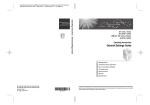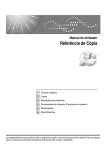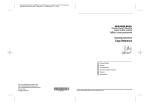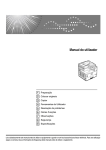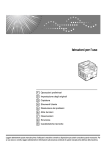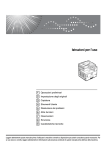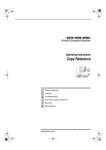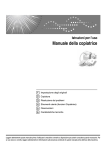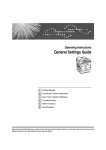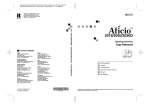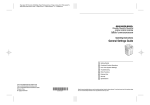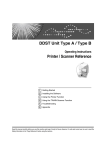Download Ricoh Aficio IS 2315 User's Manual
Transcript
Paper type: OK Prince Eco G100(55kg), Paper Thickness=80 µm // Pages in book=88 // Print scale=81%
Gap (when printed at 81% scale) = Pages in book × Paper thickness / 2 = 3.520000 mm
Operating Instructions
Operating Instructions
Operating Instructions
Type for MP1500/MP1500/Aficio MP 1500/IS2315
Printed in China
AE AE B245-7608
1
Getting Started
2
Placing Originals
3
Copying
4
User Tools
5
Troubleshooting
6
Other Functions
7
Remarks
8
Security
9
Specifications
Read this manual carefully before you use this machine and keep it handy for future reference. For safe and correct use, be sure to read the
Safety Information in this manual before using the machine.
* "#%$&
Paper type: OK Prince Eco G100(55kg), Paper Thickness=80 µm // Pages in book=88 // Print scale=81%
Gap (when printed at 81% scale) = Pages in book × Paper thickness / 2 = 3.520000 mm
Introduction
This manual contains detailed instructions and notes on the operation and use of this machine. For your
safety and benefit, read this manual carefully before using the machine. Keep this manual in a handy
place for quick reference.
In accordance with IEC 60417, this machine uses the following symbols for the main power switch:
a means POWER ON.
c means STAND BY.
Important
Contents of this manual are subject to change without prior notice. In no event will the company be liable for direct, indirect, special, incidental, or consequential damages as a result of handling or operating the machine.
Notes:
Some illustrations in this manual might be slightly different from the machine.
Certain options might not be available in some countries. For details, please contact your local dealer.
Laser Safety:
This machine is considered a class 1 laser device, safe for office/EDP use. The machine contains a 5milliwatt, 760-800 nanometer wavelength, GaAIAs laser diode. Direct (or indirect reflected ) eye contact
with the laser beam might cause serious eye damage. Safety precautions and interlock mechanisms
have been designed to prevent any possible laser beam exposure to the operator.
The following label is attached on the back side of the machine.
Caution:
Use of controls or adjustments or performance of procedures other than those specified in this manual
might result in hazardous radiation exposure.
Two kinds of size notation are employed in this manual. With this machine refer to the metric version.
For good copy quality, the supplier recommends that you use genuine toner from the supplier.
The supplier shall not be responsible for any damage or expense that might result from the use of parts
other than genuine parts from the supplier with your office products.
Power Source
220V-240V, 50/60Hz, 7A or more
Please be sure to connect the power cord to a power source as above. For details about power source,
see p.65 “Power Connection”.
Copyright © 2005
KirC3a_oi_AE-F_FM.book Page i Friday, March 10, 2006 10:25 AM
TABLE OF CONTENTS
Copyrights and Trademarks ................................................................................. 1
Trademarks ................................................................................................................1
Notice ...................................................................................................................... 2
How to Read This Manual ..................................................................................... 3
Safety Information ................................................................................................. 4
Safety During Operation.............................................................................................4
Positions of Labels and Hallmarks for RWARNING and RCAUTION Labels.... 6
ENERGY STAR Program ....................................................................................... 7
1. Getting Started
Guide to Components ........................................................................................... 9
Options ................................................................................................................. 11
External Options.......................................................................................................11
Control Panel........................................................................................................ 12
Display .....................................................................................................................13
Reading the Display and Using Keys.......................................................................14
Turning On the Power .........................................................................................15
Turning On the Main Power .....................................................................................15
Turning On the Power ..............................................................................................15
Turning Off the Power ..............................................................................................16
Turning Off the Main Power .....................................................................................16
Saving Energy..........................................................................................................16
2. Placing Originals
Originals ...............................................................................................................17
Sizes and Weights of Recommended Originals.......................................................17
Missing Image Area .................................................................................................18
Placing Originals..................................................................................................19
Original Orientation ..................................................................................................19
Placing Originals on the Exposure Glass.................................................................19
Placing Originals in the ADF ....................................................................................20
3. Copying
Basic Procedure................................................................................................... 23
Copying from the Bypass Tray........................................................................... 24
Copier Functions .................................................................................................28
Adjusting Image Density ..........................................................................................28
Selecting Original Type Setting................................................................................28
Selecting Copy Paper ..............................................................................................28
Preset Reduce/Enlarge ............................................................................................29
Zoom .......................................................................................................................29
Sort ..........................................................................................................................30
Changing the number of sets ...................................................................................31
i
KirC3a_oi_AE-F_FM.book Page ii Friday, March 10, 2006 10:25 AM
4. User Tools
User Tools Menu ( System Settings )................................................................. 33
User Tools Menu ( Copier Settings ) .................................................................. 35
Accessing User Tools .........................................................................................36
Changing Default Settings .......................................................................................36
Quitting User Tools ..................................................................................................37
Settings You Can Change with User Tools .......................................................38
System Settings .......................................................................................................38
Copier Features .......................................................................................................42
User Code .............................................................................................................44
Registering a New User Code..................................................................................44
Changing a User Code.............................................................................................45
Deleting a User Code...............................................................................................45
Displaying the Counter for Each User Code ............................................................46
Printing the Counter for Each User Code.................................................................47
Clearing the Counter ................................................................................................47
5. Troubleshooting
If Your Machine Does Not Operate As You Want..............................................49
If You Cannot Make Clear Copies.......................................................................50
If You Cannot Make Copies As You Want ......................................................... 51
When Memory Is Full ...............................................................................................51
B Loading Paper .................................................................................................52
Loading Paper..........................................................................................................52
Orientation-Fixed Paper or Two-Sided Paper ..........................................................53
D Adding Toner................................................................................................... 54
Handling Toner.........................................................................................................54
Toner Storage ..........................................................................................................54
Used Toner ..............................................................................................................54
Removing Toner................................................................................................... 55
Inserting Toner.....................................................................................................56
x Clearing Misfeeds ........................................................................................... 57
Changing the Paper Size.....................................................................................59
Changing the Paper Size of the Paper Tray ............................................................59
6. Other Functions
Other Functions ................................................................................................... 61
Displaying the Total Counter....................................................................................61
Changing the Language...........................................................................................61
ii
KirC3a_oi_AE-F_FM.book Page iii Friday, March 10, 2006 10:25 AM
7. Remarks
Do's and Don'ts.................................................................................................... 63
Where to Put Your Machine ................................................................................64
Machine Environment ..............................................................................................64
Moving......................................................................................................................64
Power Connection....................................................................................................65
Access to the Machine .............................................................................................66
Maintaining Your Machine .................................................................................. 67
Cleaning the Exposure Glass...................................................................................67
Cleaning the Exposure Glass Cover ........................................................................67
Cleaning the ADF.....................................................................................................67
8. Security
Security................................................................................................................. 69
Primary Security Functions ......................................................................................69
Operating Environment and Notes..................................................................... 70
Operating Environment ............................................................................................70
For Administrator......................................................................................................70
9. Specifications
Main Unit...............................................................................................................71
Options ................................................................................................................. 74
Exposure Glass Cover .............................................................................................74
Auto Document Feeder (ADF) .................................................................................74
Combination Chart............................................................................................... 75
Supplementary Information ................................................................................76
Copy Paper ...........................................................................................................78
Recommended Paper Sizes and Types...................................................................78
Unusable Paper .......................................................................................................79
Paper Storage ..........................................................................................................80
INDEX......................................................................................................... 81
iii
KirC3a_oi_AE-F_FM.book Page iv Friday, March 10, 2006 10:25 AM
iv
KirC3a_oi_AE-F_FM.book Page 1 Friday, March 10, 2006 10:25 AM
Copyrights and Trademarks
Trademarks
Microsoft®, Windows® and Windows NT® are registered trademarks of Microsoft Corporation in the United States and/or other countries.
Acrobat® is a registered trademark of Adobe Systems Incorporated.
Bluetooth™ is a trademark of the Bluetooth SIG, Inc. (Special Interest Group)
and is used by RICOH Company Limited under license.
Copyright ©2001 Bluetooth SIG, Inc.
The Bluetooth Trademarks are owned by Bluetooth SIG, Inc. USA.
Other product names used herein are for identification purposes only and might
be trademarks of their respective companies. We disclaim any and all rights to
those marks.
The proper names of the Windows operating systems are as follows:
• The product name of Windows® 95 is Microsoft® Windows® 95
• The product name of Windows® 98 is Microsoft® Windows® 98
• The product name of Windows® Me is Microsoft® Windows® Millennium
Edition (Windows Me)
• The product names of Windows® 2000 are as follows:
Microsoft® Windows® 2000 Professional
Microsoft® Windows® 2000 Server
Microsoft® Windows® 2000 Advanced Server
• The product names of Windows® XP are as follows:
Microsoft® Windows® XP Home Edition
Microsoft® Windows® XP Professional
• The product names of Windows Server™ 2003 are as follows:
Microsoft® Windows Server™ 2003 Standard Edition
Microsoft® Windows Server™ 2003 Enterprise Edition
Microsoft® Windows Server™ 2003 Web Edition
• The product names of Windows NT® 4.0 are as follows:
Microsoft® Windows NT® Workstation 4.0
Microsoft® Windows NT® Server 4.0
1
KirC3a_oi_AE-F_FM.book Page 2 Friday, March 10, 2006 10:25 AM
Notice
Important
Do not copy or print any item for which reproduction is prohibited by law.
Copying or printing the following items is generally prohibited by local law:
bank notes, revenue stamps, bonds, stock certificates, bank drafts, checks, passports, driver's licenses.
The preceding list is meant as a guide only and is not inclusive. We assume no
responsibility for its completeness or accuracy. If you have any questions concerning the legality of copying or printing certain items, consult with your legal
advisor.
2
KirC3a_oi_AE-F_FM.book Page 3 Friday, March 10, 2006 10:25 AM
How to Read This Manual
Symbols
The following set of symbols is used in this manual.
R WARNING:
This symbol indicates a potentially hazardous situation that might result in
death or serious injury when you misuse the machine without following the instructions under this symbol. Be sure to read the instructions, all of which are described in the Safety Information section.
R CAUTION:
This symbol indicates a potentially hazardous situation that might result in minor or moderate injury or property damage that does not involve personal injury
when you misuse the machine without following the instructions under this
symbol. Be sure to read the instructions, all of which are described in the Safety
Information section.
* The statements above are notes for your safety.
Important
If this instruction is not followed, paper might be misfed, originals might be
damaged, or data might be lost. Be sure to read this.
Preparation
This symbol indicates information or preparations required prior to operating.
Note
This symbol indicates precautions for operation, or actions to take after abnormal operation.
Limitation
This symbol indicates numerical limits, functions that cannot be used together,
or conditions in which a particular function cannot be used.
Reference
This symbol indicates a reference.
[
]
Keys that appear on the machine's display panel.
{
}
Keys built into the machine's control panel.
3
KirC3a_oi_AE-F_FM.book Page 4 Friday, March 10, 2006 10:25 AM
Safety Information
When using this machine, the following safety precautions should always be followed.
Safety During Operation
In this manual, the following important symbols are used:
R WARNING:
Indicates a potentially hazardous situation which, if instructions
are not followed, could result in death or serious injury.
R CAUTION:
Indicates a potentially hazardous situation which, if instructions are not
followed, may result in minor or moderate injury or damage to property.
R WARNING:
• Disconnect the power plug (by pulling the plug, not the cable) if the
power cable or plug becomes frayed or otherwise damaged.
• To avoid hazardous electric shock or laser radiation exposure, do not
remove any covers or screws other than those specified in this manual.
• Turn off the power and disconnect the power plug (by pulling the plug,
not the cable) if any of the following occurs:
• You spill something into the machine.
• You suspect that your machine needs service or repair.
• The external housing of your machine has been damaged.
• Do not incinerate spilled toner or used toner. Toner dust might ignite
when exposed to an open flame.
• Disposal can take place at our authorized dealer.
• Dispose of the used toner bottle in accordance with the local regulations.
• Connect the machine only to the power source described on the inside
front cover of this manual. Connect the power cord directly into a wall
outlet and do not use an extension cord.
• Do not damage, break or make any modifications to the power cord.
Do not place heavy objects on it. Do not pull it hard nor bend it more
than necessary. These actions could cause an electric shock or fire.
4
KirC3a_oi_AE-F_FM.book Page 5 Friday, March 10, 2006 10:25 AM
R CAUTION:
• Protect the machine from dampness or wet weather, such as rain and snow.
• Unplug the power cord from the wall outlet before you move the machine.
While moving the machine, you should take care that the power cord will not
be damaged under the machine.
• When you disconnect the power plug from the wall outlet, always pull the
plug (not the cable).
• Do not allow paper clips, staples, or other small metallic objects to fall inside
the machine.
• Keep toner (used or unused) and toner bottle out of the reach of children.
• For environmental reasons, do not dispose of the machine or expended
supply waste at household waste collection points. Disposal can take place
at an authorized dealer.
• The inside of the machine could be very hot. Do not touch the parts with a
label indicating the “hot surface”. Otherwise, an injury might occur.
• Keep the machine away from humidity and dust. Otherwise a fire or an electric shock might occur.
• Do not place the machine on an unstable or tilted surface. If it topples over,
an injury might occur.
• Before moving the machine, be sure to pull all four handles fully out. If not,
an injury might occur. After moving the machine, return the four handles to
their original positions.
• When the optional paper tray unit is installed, do not push the upper part of
the main unit horizontally. An injury might occur if the paper tray unit becomes detached from the main unit.
• If you use the machine in a confined space, make sure there is a continuous
air turnover.
• Keep the machine away from flammable liquids, gases, and aerosols. A fire
or an electric shock might occur.
5
KirC3a_oi_AE-F_FM.book Page 6 Friday, March 10, 2006 10:25 AM
Positions of Labels and Hallmarks for
RWARNING and RCAUTION Labels
This machine has labels for RWARNING and RCAUTION at the positions
shown below. For safety, please follow the instructions and handle the machine
as indicated.
APH002S
6
KirC3a_oi_AE-F_FM.book Page 7 Friday, March 10, 2006 10:25 AM
ENERGY STAR Program
As an ENERGY STAR Partner, we have determined
that this machine model meets the ENERGY STAR
Guidelines for energy efficiency.
The ENERGY STAR Guidelines intend to establish an international energy-saving system for
developing and introducing energy-efficient office equipment to deal with environmental issues, such as global warming.
When a product meets the ENERGY STAR Guidelines for energy efficiency, the Partner shall
place the ENERGY STAR logo onto the machine model.
This product was designed to reduce the environmental impact associated with office equipment by means of energy-saving features, such as Low-power mode.
• Low Power mode
This product automatically lowers its power consumption 1 minute after finishing the last copy job. To make copies, you have to press the operation
switch first.
For details about how to change the interval between last job and Low Power
mode, see p.39 “Energy Saver Timer”.
• Off mode
To conserve energy, this product automatically turns off 1 minute after finishing the last copy job. In this manual, the Off mode is called the Auto Off mode.
For details about how to change the interval between last job and Auto Off
mode, see p.39 “Auto Off Timer”.
Note
• If you want to operate this product while it is in either of these modes, do
one of the following:
• Turn on the operation switch.
• Place originals in the ADF (Auto Document Feeder).
• Lift the exposure glass cover or ADF.
Specifications
Off mode
Power consumption
less than 1 W
Default interval
1 minute
Recovery time
Less than 10 seconds
7
KirC3a_oi_AE-F_FM.book Page 8 Friday, March 10, 2006 10:25 AM
Recycled Paper
In accordance with the ENERGY STAR Program, we recommend use of recycled
paper which is environmentally friendly. Please contact your sales representative for recommended paper.
8
KirC3a_oi_AE-F_FM.book Page 9 Friday, March 10, 2006 10:25 AM
1. Getting Started
Guide to Components
APH016S
1. Exposure glass cover (optional) or
ADF (optional).
See p.11 “External Options”
(The illustration shows the ADF.)
2. Exposure glass
Place originals here face down.
5. Main power switch
If the machine does not operate after
turning on the operation switch, check
the main power switch is turned on. If it
is off, turn it on.
6. Main power indicator
Copied paper is delivered here.
Lights when the main power switch is
turned on, and goes off when the switch
is turned off.
4. Ventilation holes
7. Operation switch (On indicator)
Prevents overheating. Do not obstruct
the ventilation holes by placing objects
near them or leaning things against them.
If the machine overheats, a fault might
occur.
Press to turn the power on (the On indicator lights). To turn the power off, press
again (the On indicator goes off).
3. Internal tray
8. Control panel
See p.12 “Control Panel”.
9
KirC3a_oi_AE-F_FM.book Page 10 Friday, March 10, 2006 10:25 AM
Getting Started
9. Front cover
10. Paper tray
Open to access the inside of the machine.
Load paper here.
1. Bypass tray
2. Right cover
Use to copy onto OHP transparencies,
adhesive labels, translucent paper, envelopes, and custom size paper.
Open this cover to remove jammed paper
fed from the paper tray.
1
10
KirC3a_oi_AE-F_FM.book Page 11 Friday, March 10, 2006 10:25 AM
Options
Options
External Options
1
1. Exposure glass cover
2. ADF
Lower this cover over originals.
Place stacks of originals here.
They will feed in automatically.
11
KirC3a_oi_AE-F_FM.book Page 12 Friday, March 10, 2006 10:25 AM
Getting Started
Control Panel
This illustration shows the control panel of the machine with options fully installed.
1
User Tools/Counter
ABC
Escape
DEF
GHI
JKL
MNO
PQRS
TUV
WXYZ
ClearModes
Clear/Stop
OK
Start
Original
Text
Sort
Lighter
Darker
Photo
Enter
APH101S
1. Indicators
5. {User Tools/Counter} key
Display errors and machine status.
h: Error indicator. See p.57 “x Clearing
Misfeeds”.
B: Load Paper indicator. See p.52 “B
Loading Paper”.
D: Add Toner indicator. See p.54 “D
Adding Toner”.
• User Tools
Press to change default or operation
parameters according to requirement.
See p.36 “Accessing User Tools”.
• Counter
Press to check or print the counter value. See p.61 “Other Functions”.
2. Display
Displays operation status and messages.
3. Selection keys
Correspond to items on the display. Press
to select the corresponding item.
4. Scroll keys
Press to select an item.
{U} : scroll upward
{T} : scroll downward
{V} : scroll right
{W} : scroll left
Reference
See p.14 “Reading the Display and
Using Keys”.
6. {Clear Modes} key
Press to clear the current settings.
7. {Clear/Stop} key
• Clear:
Clears an entered numeric value.
• Stop:
Stops a job in progress, such as scanning, or printing.
8. Main power indicator
The main power indicator lights when
the main power switch is turned on.
Important
❒ Do not turn off the main power
switch while the On indicator is lit
or blinking. Doing so may damage
the memory.
Reference
p.15 “Turning On the Power”
12
KirC3a_oi_AE-F_FM.book Page 13 Friday, March 10, 2006 10:25 AM
Control Panel
9. Operation switch (On indicator)
13. {Original Type} key
Press to turn the power on. The On indicator lights. To turn the power off, press
again.
Press to select the original type registered
in [Original Type 1 (Text)] or [Original Type 2
(Photo)]. When the original type is selected, the corresponding indicator lights.
Note
❒ This key is inactivate during scanning
or while setting defaults.
1
14. {OK} key
Press to set a selected item or an entered
numeric value.
Reference
p.15 “Turning On the Power”
15. Number keys
Press to enter numeric values.
10. {Sort} key
16. {#} key
Automatically sorts copies.
Press to set a selected item or an entered
numeric value.
11. {Lighter} and {Darker} keys
Press to change the image density setting.
Select the image density in three increments, Lighter to Darker.
17. {Start} key
Press to start copying, printing, or scanning or sending.
12. {Escape} key
Press to cancel an operation or return to
the previous display.
Display
The display panel shows machine status, error messages, and function menus.
Important
❒ A force or impact of more than 30 N (about 3 kgf) will damage the display.
❖ Initial copy display
1
2
3
AAX024S
4
AAI024S
1. Operational status or messages
2. Messages and the selected tray ap-
3. Number of copies set.
4. Reduce/Enlarge ratio function for
pear here. Currently selected items
non-fixed ratios.
appear in brackets.
When you select or specify an item on the display, it is highlighted like
.
13
KirC3a_oi_AE-F_FM.book Page 14 Friday, March 10, 2006 10:25 AM
Getting Started
Reading the Display and Using Keys
This section explains how to read the display and use the Selection keys.
1
Escape
OK
APH102S
1. Selection keys
2. {Escape} key
Correspond to items at the bottom line on
the display.
Example: The Copy display
Press to cancel an operation or return to
the previous display.
• When the instruction “press [100%] ”
appears in this manual, press the left
selection key.
• When the instruction “press [R/E] ”
appears in this manual, press the centre selection key.
Press to set a selected item or an entered
numeric value.
3. {OK} key
4. Scroll keys
Press to move the cursor in each direction, step by step.
When the {U}, {T}, {W}, or {V} key appears in this manual, press the scroll key
of the same direction.
Common key operations
The following keys are common to all screens:
❖ Key list
14
[Cancel]
Deletes a selected function or entered values, and then the previous
display returns.
[Exit]
The previous display returns.
[Stop]
Stops a job in progress.
[Yes]
Acknowledges a selected function or an entered values.
[Stop]
Cancels a selected function or entered values, and then the previous
display returns.
KirC3a_oi_AE-F_FM.book Page 15 Friday, March 10, 2006 10:25 AM
Turning On the Power
Turning On the Power
This machine has two power switches.
❖ Operation switch (right side of the control panel)
Press to activate the machine. When
the machine has finished warming
up, you can operate the machine.
❖ Main power switch (left side of the machine)
Turning off this switch makes the
main power indicator on the right
side of the control panel go off.
When this is done, machine power
is completely off.
Note
❒ This machine automatically enters
Energy Saver mode or turns itself
off if you do not use it for a while.
Important
❒ Do not turn off the main power
switch immediately after turning it on. Doing so may result in
damage to the memory, leading
to malfunctions.
1
Turning On the Power
A Press the operation switch.
The On indicator goes on.
arModes
ar/Stop
Start
Turning On the Main Power
A Make sure the power cord is firmly plugged into the wall outlet.
B Turn on the main power switch.
The main power indicator goes on.
APE030S
Note
❒ If the power does not come on
when the operation switch is
pressed, check the main power
switch is on. If it is off, turn it on.
AAI049S
15
KirC3a_oi_AE-F_FM.book Page 16 Friday, March 10, 2006 10:25 AM
Getting Started
Turning Off the Power
Saving Energy
A Press the operation switch.
1
The On indicator goes off.
-Auto Off / Low Power
The machine automatically turns itself off when the job is finished, after
a certain period of time has elapsed.
This function is called “Auto Off”.
arModes
ar/Stop
Start
APE030S
Turning Off the Main Power
Important
❒ Do not turn off the main power
switch when the On indicator is lit
or blinking. Doing so may result in
damage to the memory.
❒ Be sure to turn off the main power
switch before pulling out the power plug. Not doing this may result
in damage to the memory.
A Be sure the On indicator is not lit.
B Turn off the main power switch.
The main power indicator goes
out.
16
Note
❒ You can change the Auto Off time.
❒ The Auto Off Timer function will
not operate in the following cases:
• When a warning message appears
• When the service call message
appears
• When paper is jammed
• When the cover is open
• When the “ Add toner ” message appears
• When toner is being replenished
• When the User Tools screen is
displayed
• When fixed warm-up is in
progress
KirC3a_oi_AE-F_FM.book Page 17 Friday, March 10, 2006 10:25 AM
2. Placing Originals
Originals
Sizes and Weights of Recommended Originals
❖ Metric version
Original location
Original size
Original weight
Exposure glass
Up to A3
--
ADF
One-sided originals:
40–128 g/m2
A3L – A5KL
❖ Inch version
Original location
Original size
Original weight
Exposure glass
Up to 11" × 17"
--
ADF
One-sided originals:
11–34 lb.
11" × 17"L – 51/2" × 81/2"KL
Note
❒ About 30 originals can be placed in the ADF.
17
KirC3a_oi_AE-F_FM.book Page 18 Friday, March 10, 2006 10:25 AM
Placing Originals
Non-compatible originals for the ADF
Placing the following types of originals in the ADF can cause paper misfeeds or
result in damage to the originals. Place these originals on the exposure glass instead.
• Originals other than those specified on p.17 “Sizes and Weights of Recommended Originals”
• Stapled or clipped originals
• Perforated or torn originals
• Curled, folded, or creased originals
• Pasted originals
• Originals with any kind of coating, such as art paper, aluminum foil, carbon
paper, or conductive paper
• Originals with perforated lines
• Originals with indexes, tags, or other projecting parts
• Sticky originals such as translucent paper
• Thin, highly flexible originals
• Thick originals such as postcards
• Bound originals such as books
• Transparent originals such as OHP transparencies or translucent paper
2
Note
❒ The original might become dirty if it is written with a pencil or a similar
tool.
Missing Image Area
Even if you place originals in the ADF, or on the exposure glass correctly, 4 mm
(0.2”) margins on all four sides might not be copied.
18
KirC3a_oi_AE-F_FM.book Page 19 Friday, March 10, 2006 10:25 AM
Placing Originals
Placing Originals
Note
❒ Take care to place originals only after any correction fluid and ink has
completely dried. Not taking this
precaution could cause marks on
the exposure glass that will be copied onto paper.
Reference
For original sizes you can set, see
p.17 “Originals” .
Original Orientation
You can set the original orientation in
the following ways.
This function is useful for copying
torn or large originals.
Note
❒ Originals should normally be
aligned to the rear left corner.
However, some copy functions
may produce different results depending on the orientation of the
originals. For details, see the explanations of each function.
Originals
ADF
Placing Originals on the
Exposure Glass
A Lift
2
the exposure glass cover or
ADF.
Important
❒ Do not lift the exposure glass
cover or ADF forcefully. If you
do, the ADF cover might open
or be damaged.
Note
❒ Be sure to lift the exposure glass
cover or ADF by more than 30°.
Otherwise, the size of the original might not be detected correctly.
B Place the original face down on
the exposure glass. It should be
aligned with the rear left corner.
Exposure
glass
AAI025S
set11EE
1. Positioning mark
2. Left scale
Note
❒ Start with the first page to be
copied.
set23EE
C Lower the exposure glass cover or
ADF.
19
KirC3a_oi_AE-F_FM.book Page 20 Friday, March 10, 2006 10:25 AM
Placing Originals
Placing Originals in the ADF
Settings should be made in the following situations:
B Align the edges of the originals
and place them in the ADF with
the side to be copied facing up.
❖ When placing custom size originals:
p.20 “Placing custom size originals”
2
Note
❒ Do not stack originals over the limit mark on the side fence of the
ADF.
❒ The last page should be on the bottom.
❒ Do not cover the sensors with your
hands, or place objects on them.
Doing so could cause the size to be
detected incorrectly, or the paper
misfeed error message to appear.
Also, do not place anything on the
cover, as this too could cause a
malfunction.
❖ ADF
AAI026S
1. Limit mark
2. Document guide
Note
❒ Straighten curls in the originals
before placing them in the ADF.
❒ To prevent multiple sheets feeding in at once, fan the originals
before placing them in the ADF.
❒ Set the original squarely.
Placing custom size originals
When placing custom size originals in
the ADF, specify the size of the originals.
AAI036S
1. Sensor
A Set
the document guide to the
original size.
Note
❒ Paper that has a vertical length of
105–297 mm (4.2"–11.6") and a horizontal length of 128–1260 mm
(5.1"–49.6") can be placed with this
function.
A Select the paper tray using {U} or
{T}, and then press the {#} key.
20
KirC3a_oi_AE-F_FM.book Page 21 Friday, March 10, 2006 10:25 AM
Placing Originals
B Select [Custom Size] using {U} or
{T} key, and then press the {OK}
key.
When the custom size originals
settings are registered,
appears on the top of copy display.
2
Note
❒ When [Auto Detect] is selected,
the size of the placed original
will be detected automatically.
C Enter
the horizontal size of the
original using the number keys,
and then press the {OK} key.
Note
❒ If you make a mistake, press the
{Clear/Stop} key, and then enter
the value again.
D Enter the vertical size of the origi-
Note
❒ To cancel the size you have set,
press the {Clear Modes} key.
Placing regular size originals
A Select the paper tray using {U} or
{T} key, and then press the {#}
key.
B Select [Regular Size] using {U} or
{T} key, and then press the {OK}
key.
nal using the number keys, and
then press the {OK} key.
The “ Programmed ” message appears with your set original size.
Note
❒ When [Auto Detect] is selected,
the size of the placed original
will be detected automatically.
21
KirC3a_oi_AE-F_FM.book Page 22 Friday, March 10, 2006 10:25 AM
Placing Originals
C Select
the paper size using the
scroll keys, and then press {OK}
key.
2
The “ Programmed ” message appears.
When the regular size originals
settings are registered,
appears on the top of copy display.
Note
❒ To cancel the size you have set,
press the {Clear Modes} key.
22
KirC3a_oi_AE-F_FM.book Page 23 Friday, March 10, 2006 10:25 AM
3. Copying
Basic Procedure
A If the machine has user codes set,
enter a user code (up to eight digits) using the number keys, and
then press the {OK} or {#} key.
The machine is ready to copy.
Reference
For user codes, see p.40 “Key
Operator Tools”.
B Make sure "d Ready" appears on
the display.
❖ Initial copy display
F Enter the number of copies using
the number keys.
Note
❒ The maximum copy quantity
that can be set is 99.
G Press the {Start} key.
Copying starts.
Note
❒ Copies are delivered face down.
C Make
sure no previous settings
remain.
Note
❒ When there are previous settings remaining, press the {Clear
Modes} key and enter again.
D Place your originals.
Reference
p.19 “Placing Originals”
E Make the necessary settings.
Reference
See the explanations for each
function.
-How to operate
❖ To switch between pages or select
functions:
Press the scroll key.
❖ To stop the machine during a multicopy run:
Press the {Clear/Stop} key.
❖ To return the machine to the initial
condition after copying:
Press the {Clear Modes} key.
❖ To clear an entered value.
Press the {Clear/Stop} key.
23
KirC3a_oi_AE-F_FM.book Page 24 Friday, March 10, 2006 10:25 AM
Copying
Copying from the Bypass Tray
Use the bypass tray to copy onto OHP
transparencies, thick paper, envelopes and copy paper that cannot be
loaded in the paper tray.
A Open the bypass tray.
Important
❒ Paper longer than 433 mm may become wrinkled, may not feed in,
and may jam.
3
Note
❒ If you do not use standard size
copy paper, or if you use special
paper, you should enter its vertical
and horizontal dimensions. See
p.20 “Placing custom size originals”. The sizes you can enter are
as follows:
Metric
version
• Vertical: 90–297 mm
Inch
version
• Vertical: 3.55"–11.69"
B Push up the paper guide release
lever.
• Horizontal: 148–600 mm
• Horizontal: 5.83"–23.62”
1
❒ The machine can automatically detect the following sizes as regular
size copy paper:
ZENY110E
Metric
version
A3L, A4KL, A5KL, 8" ×
13"L
Inch
version
11" × 17"L, 81/2" × 11"KL,
51/2" ×81/2"L, 81/2" × 14"L
❒ When copying onto OHP transparencies or paper heavier than 105
g/m2 (about 28 lb.), you need to
specify the paper type. See p.26
“When copying onto special paper” .
❒ The maximum number of sheets
you can load at the same time depends on paper type. The maximum number of sheets should not
exceed the upper limit.
24
1. Paper guide release lever
KirC3a_oi_AE-F_FM.book Page 25 Friday, March 10, 2006 10:25 AM
Copying from the Bypass Tray
C Insert the paper with the side you
want to copy facing down, and
then adjust the paper guide with
the paper size.
4
D Pull down the paper guide release
lever (step B).
The bypass tray is selected on the
display.
1
2
3
ZENY120E
1. Horizontal size
2. Vertical size
3. Extender
4. Paper guides
Note
❒ If the guides are not flush
against the copy paper, images
might be skewed or paper misfeeds might occur.
❒ Do not stack paper over the limit mark, otherwise images
might be skewed or paper misfeeds might occur.
❒ Swing out the extender to support paper sizes larger than
A4L, 81/2" × 11"L.
❒ Fan paper to get air between the
sheets and avoid a multi-sheet
feed.
3
Note
❒ If [Byp.] is not selected on the
display, select [Byp.] using {U}
or {T}, and then press the {#}
key.
E Select the paper size and type.
When copying onto regular size
paper
A Select [Paper Size] using {U} or
{T}, and then press the {OK}
key.
B Select [Regular Size] using {U}
or {T}, and then press the {OK}
key.
25
KirC3a_oi_AE-F_FM.book Page 26 Friday, March 10, 2006 10:25 AM
Copying
C Select the paper size using the
scroll keys, and then press the
{OK} key.
Note
❒ If you make a mistake, press
the {Clear/Stop} key, and then
enter the value again.
D Enter the vertical size of the
original using the number
keys, and then press the {OK}
key.
The “ Programmed ” message
appears.
3
When copying onto custom size
paper
Important
❒ You should specify the size of
copy paper to avoid paper misfeeds.
When copying onto special paper
A Select [Paper Size] using {U} or
{T}, and then press the {OK}
key.
A Select [Paper Type] using {U} or
{T}, and then press the {OK}
key.
B Select [Custom Size] using {U}
or {T}, and then press the {OK}
key.
B Select the paper type, and then
press the {OK} key.
C Enter the horizontal size of the
original using the number
keys, and then press the {OK}
key.
26
The “ Programmed ” message
appears.
The “ Programmed ” message
appears.
KirC3a_oi_AE-F_FM.book Page 27 Friday, March 10, 2006 10:25 AM
Copying from the Bypass Tray
When copying onto envelopes
A Select [Paper Size] using {U} or
{T}, and then press the {OK}
key.
B Select [Regular Size] using {U}
or {T}, and then press the {OK}
key.
E Select [Paper Type] using {U} or
{T}, and then press the {OK}
key.
F Select [Thick Paper] using {U} or
{T}, and then press the {OK}
key.
3
The “ Programmed ” message
appears.
C Select the envelope size from
[C6 envL] [C5 envL] [DL envL],
and then press the {OK} key.
F Place
your originals, and then
press the {Start} key.
Note
❒ When copying onto OHP transparencies, remove copied sheets
one by one.
The “ Programmed ” message
appears.
D Press the {#} key.
27
KirC3a_oi_AE-F_FM.book Page 28 Friday, March 10, 2006 10:25 AM
Copying
Copier Functions
A Press the {Original Type} key and
Adjusting Image Density
select the original type.
GHI
You can adjust copy image density to
match your originals.
If you require darker or lighter copies, adjust image density accordingly.
A Press the {Lighter} or {Darker} key
3
Escape
OK
PQRS
Original
Text
Darker
Photo
to adjust the density.
Escape
APE046S
Orig
T
Lighter
Darker
P
Note
❒ Press the {Original Type} key to
go through the following types:
Upper indicator lit Text
Lower indicator lit Photo
APH020S
Selecting Original Type
Setting
Select one of the following two types
to match your originals:
❖ Text
Select this when your originals
contain only text (no pictures).
Selecting Copy Paper
Choose the tray containing the paper
you want to copy onto: a paper tray or
the bypass tray.
A Select
the paper tray or bypass
tray using {U} or {T}.
The selected tray and the paper
size appear.
❖ Photo
This can reproduce delicate tones
of photographs and pictures.
Reference
p.42 “Original Type Setting”
Reference
p.24 “Copying from the Bypass
Tray”
28
KirC3a_oi_AE-F_FM.book Page 29 Friday, March 10, 2006 10:25 AM
Copier Functions
A Press [R/E].
Preset Reduce/Enlarge
You can select a preset ratio for copying.
B Press [Reduce] or [Enlarge].
3
❖ Base Point
The base point of Reduce/Enlarge
differs depending on how the original is scanned. When the original
is placed on the exposure glass, the
upper left corner is the base point.
When placed in the ADF, the bottom left corner is the base point.
C Select a ratio using {U} or {T},
and then press the {OK} key.
The “ Programmed ” message appears.
D Place
your originals, and then
press the {Start} key.
Zoom
You can change the reproduction ratio in increments of 1%.
GCKA031e
1. Base point when placing on the
exposure glass.
2. Base point when placing in the
ADF.
Reference
Related default settings
p.43 “Reproduction Ratio”
p.43 “Preset R/E Priority”
Note
❒ You can also select a preset ratio
close to the desired ratio using [Reduce] or [Enlarge], and then adjust
the ratio using {U} or {T}.
29
KirC3a_oi_AE-F_FM.book Page 30 Friday, March 10, 2006 10:25 AM
Copying
A Press [R/E].
B Press [Zoom].
To enter the ratio using the
number keys
A Enter the desired ratio using
the number keys.
B Press the {OK} key.
The “ Programmed ” message
appears.
D Place
your originals, and then
press the {Start} key.
3
Sort
C Enter the ratio.
You can scan originals into memory
and automatically sort copies.
❖ Sort
Copies are assembled as sequentially ordered sets.
To select the ratio using {U} and
{T}
A Adjust the ratio using {U} or
{T}.
Note
❒ If you have incorrectly entered the ratio, readjust using
{U} or {T}.
❒ To change the ratio in increments of 10%, press and hold
down {U} or {T}.
B Press the {OK} key.
The “ Programmed ” message
appears.
A Press the {Sort} key.
Sort
Lighter
APH021S
Note
❒ When canceling the Sort function, press the {Sort} key, and
make sure the {Sort} key indicator is off.
30
KirC3a_oi_AE-F_FM.book Page 31 Friday, March 10, 2006 10:25 AM
Copier Functions
B Enter the number of copy sets using the number keys.
Changing the number of sets
You can change the number of copy
sets during copying.
C Place your originals.
Note
❒ When placing originals on the
exposure glass, start from the
first page to be copied. When
placing originals in the ADF, set
the first page on top.
Note
❒ This function can only be used
when the Sort function is selected.
A While
“ Copying... ” is displayed, press the {Clear/Stop} key.
3
B Press [Sets].
D Press the {Start} key.
Note
❒ When placing originals on the
exposure glass, press the {#}
key after all originals are
scanned.
C Enter
the number of copy sets
with the number keys, and then
press [Resume].
Copying starts again.
Note
❒ The number of sets you can enter differs depending on when
the {Clear/Stop} key is pressed.
31
KirC3a_oi_AE-F_FM.book Page 32 Friday, March 10, 2006 10:25 AM
Copying
3
32
KirC3a_oi_AE-F_FM.book Page 33 Friday, March 10, 2006 10:25 AM
4. User Tools
User Tools Menu ( System Settings )
❖ General Features (See p.38 “General Features”.)
Default
Copy Count Display
Up
Display Contrast
Centre
Key Repeat
On
Measurement Unit
Metric version: mm
Inch verion: inch
❖ Tray Paper Settings (See p.38 “Tray Paper Settings”.)
Default
Tray Paper Size: Tray 1
Metric version: 81/2" × 11" L
Inch version: A4L
Paper Type: Bypass tray
Thick Paper
❖ Timer Settings (See p.39 “Timer Settings”.)
Default
Auto Off Timer
1 min.
Energy Saver Timer
1 min.
System Auto Reset Timer
60 sec.
Copier Auto Reset Timer
60 sec.
33
KirC3a_oi_AE-F_FM.book Page 34 Friday, March 10, 2006 10:25 AM
User Tools
❖ Key Operator Tools (See p.40 “Key Operator Tools”.)
Default
User Code Man.: Copier
Off
Key Counter Management
Off
Key Operator Code
Off
Display/Print Counter
—
Counter per User Code
Program/Change User Code
4
Display
—
Print
—
Clear
—
Program
—
Change
—
Delete
AOF (Always On)
34
—
On
KirC3a_oi_AE-F_FM.book Page 35 Friday, March 10, 2006 10:25 AM
User Tools Menu ( Copier Settings )
User Tools Menu ( Copier Settings )
❖ Copier Features (See p.42 “Copier Features”.)
Default
Original Type Setting
Original Type 1 (Text): Text Mode 1
Original Type 2 (Photo): Photo Mode 1
Max. Number of Sets
Original Count Display
Reproduction Ratio
99 sheets
Off
Metric version:
• Ratio 1: 50%
• Ratio 2: 71%
4
• Ratio 3: 82%
• Ratio 4: 93%
• Ratio 5: 122%
• Ratio 6: 141%
• Ratio 7: 200%
Inch version:
• Ratio 1: 50%
• Ratio 2: 65%
• Ratio 3: 78%
• Ratio 4: 93%
• Ratio 5: 121%
• Ratio 6: 129%
• Ratio 7: 155%
Preset R/E Priority
Metric version: 71%
Inch version: 65%
Letterhead Setting
Off
35
KirC3a_oi_AE-F_FM.book Page 36 Friday, March 10, 2006 10:25 AM
User Tools
Accessing User Tools
This section is for key operators in
charge of this machine.
User Tools allow you to change or set
defaults.
Note
❒ Operations for system settings differ from normal operations. Always quit User Tools when you
have finished. See p.37 “Quitting
User Tools”.
❒ Selected settings are highlighted.
❒ Any changes you make with User
Tools remain in effect even if the
main power switch or operation
switch is turned off, or the {Clear
Modes} key is pressed.
4
Changing Default Settings
Note
❒ If a key operator code is already
set, the key operator code entry
display appears. Enter the key operator code, and then press the
{OK} key. See p.40 “Key Operator
Code”.
B Select
[System Settings] or [Copier
Features] using {U} or {T}, and
then press the {OK} key.
C Select the menu using {U} or {T},
and then press the {OK} key.
Reference
p.33 “User Tools Menu ( System
Settings )”p.35 “User Tools
Menu ( Copier Settings )”.
D Select the item using {U} or {T },
and then press the {OK} key.
A Press the {User Tools/Counter} key.
User Tools/Counter
ABC
DEF
JKL
MNO
E Change settings by following in-
ClearModes
structions on the display, and
then press the {OK} key.
Clear/Stop
Start
TUV
WXYZ
APE044S
36
Note
❒ To cancel changes made to settings and return to the initial
display, press the {User
Tools/Counter} key.
KirC3a_oi_AE-F_FM.book Page 37 Friday, March 10, 2006 10:25 AM
Accessing User Tools
Quitting User Tools
A Press the {User Tools/Counter} key.
User Tools/Counter
ABC
DEF
JKL
MNO
TUV
WXYZ
ClearModes
Clear/Stop
Start
4
APE044S
37
KirC3a_oi_AE-F_FM.book Page 38 Friday, March 10, 2006 10:25 AM
User Tools
Settings You Can Change with User Tools
Reference
To access User Tools, see p.36 “Accessing User Tools”.
System Settings
General Features
❖ Copy Count Display
The copy counter can be set to
show the number of copies made
(count up), or the number of copies
yet to be made (count down).
4
Note
❒ Default: Up (count up)
❖ Display Contrast
You can adjust the brightness of
the display.
❖ Key Repeat
You can select whether or not to
use the key repeat function.
Note
❒ Default: On
❖ Measurement Unit
You can switch the measurement
between “mm” and “inch”.
Note
❒ Default:
• Metric version: mm
• Inch version: inch
Tray Paper Settings
❖ Tray Paper Size: Tray 1
Select the size of the paper loaded
in the paper tray.
• The paper sizes you can set for
Tray 1 are as follows:
A3L, B4JIS (Japanese Industrial Standard)L, A4KL,
B5JISKL, A5K, 11" × 17"L,
8 1 / 2 " × 14"L, 8 1 / 2 " × 13"L,
81/4" × 14"L, 81/4" × 13"L, 8" ×
13"L, 81/2" × 11"KL, 71/4" ×
10 1 / 2 "KL, 5 1 / 2 " × 8 1 / 2 "K,
8KL, 16KKL
Important
❒ If the specified paper size differs from the actual size of the
paper loaded in the paper tray,
a misfeed might occur because
the correct paper size was not
detected.
Note
❒ Default:
• Metric version: 81/2" × 11"L
• Inch version: A4L
❒ If the paper size set for the selector in the paper tray is different
from the paper size for this setting, the paper size of the selector has priority.
❒ If you load paper of a size not
indicated on the paper size selector in the paper tray, set the
selector to “p”.
Reference
p.59 “Changing the Paper Size”
38
KirC3a_oi_AE-F_FM.book Page 39 Friday, March 10, 2006 10:25 AM
Settings You Can Change with User Tools
❖ Paper Type: Bypass tray
Set the display so you can see what
type of paper is loaded in the bypass tray.
• The paper types you can set for
the bypass tray are as follows:
• recycled paper, special paper, colour paper, letterhead,
prepunched paper, label paper, bond paper, thick paper,
OHP, cardstock
Note
❒ Default: Thick Paper
❒ Paper types you can set in the
bypass tray for machines with
the copy function only are plain
paper, thick paper and OHP.
Timer Settings
❖ Auto Off Timer
Afte r a spe cifi ed pe r iod ha s
passed, following job completion,
the machine automatically turns
off, in order to conserve energy.
This function is called “Auto Off”.
The machine status after the Auto
Off operation is referred to as “Off
mode”. For the Auto Off Timer,
specify the time to elapse before
Auto Off.
Note
❒ Default: 1 min.
❒ The time can be set from 1 to 240
minutes, using the number
keys.
❒ From “Off mode”, the machine
is ready to use within 10 seconds.
❒ Auto Off may not work when
error messages appear.
❖ Energy Saver Timer
The machine automatically enters
Low Power mode automatically
after a job is finished, and the selected time elapsed.
Note
❒ Default: 1 min.
❒ The time can be set from 1 to 240
minutes, using the number key.
❒ Energy Saver may not work
when error messages appear.
❖ System Auto Reset Timer
The System Reset setting automatically switches the screen to the
copier display when no operations
are in progress, or when an interrupted job is cleared. This setting
determines the system reset interval.
4
Note
❒ Default: On, 60 sec.
❒ The time can be set from 10 to
999 seconds, using the number
keys.
❖ Copier Auto Reset Timer
Specify the time to elapse before
copier modes reset.
Note
❒ If [Off] is selected, the machine
does not automatically switch
to the user code entry screen.
❒ Default: On, 60 sec.
❒ The time can be set from 10 to
999 seconds, using the number
keys.
39
KirC3a_oi_AE-F_FM.book Page 40 Friday, March 10, 2006 10:25 AM
User Tools
Key Operator Tools
The key operator must set the following items. For settings or more information, contact the key operator.
It is recommended that the key operator program a key operator code
when performing the settings. See
p.40 “Key Operator Code”.
❖ User Code Man.: Copier
Allows you to control who uses the
machine by setting codes for users.
User codes must be registered for
user code management.
4
Note
❒ Default: Off
❖ Key Counter Management
Use the key counter to specify
whether users are restricted or not.
Note
❒ Default: Off
❒ [Key Counter Management] will
only be displayed when the key
counter is set.
❖ Key Operator Code
Specify whether or not to use passwords (max. eight digits) to control Key Operator Tools settings
for key operator code.
Note
❒ Default: Off
❒ If you select [On], enter the key
operator code (max. eight digits) using the number keys, and
then select [On:Partial] or [On:All]
to set the access limit.
• If you selected [On:Partial]
A key operator code is only
required for the Timer Settings and Key Operator
Tools for System Settings.
• If you selected [On:All]
A key operator code is required to access all items in
System Settings and Copier
Features.
❒ If you select [On:All], you must
enter a key operator code to access the Key Operator Code display.
❖ Display/Print Counter
Allows you to view and print the
number of prints.
• Display/Print Counter
Displays the number of prints
for each function (Total, Copier
and A3/DLT).
• Print Counter List
Prints out a list of the number of
prints made under each function.
• To print the counter list
A Press the {User Tools/Counter}
key.
User Tools/Counter
ABC
DEF
JKL
MNO
TUV
WXYZ
ClearModes
Clear/Stop
Start
40
APE044S
KirC3a_oi_AE-F_FM.book Page 41 Friday, March 10, 2006 10:25 AM
Settings You Can Change with User Tools
B
C
Select [System Settings] using
{U} or {T}, and then press
the {OK} key.
Select [Key Operator Tools] using {U} or {T}, and then
press the {OK} key.
D
Select [Display/Print Counter]
using {U} or {T}, and then
press the {OK} key.
E
Press [Print].
F
Press the {Start} key.
❖ Counter per User Code
Allows you to view and print the
numbers of prints accessed with
user codes, and to set those values
to 0.
Note
❒ Press {U} and {T} to show all
the numbers of prints.
❒ The number of prints may differ
from the counter value shown
in Display/Print Counter.
• Print counter per user code
Prints the number of prints
made under each user code.
• Clear counter per user code
Sets the number of prints
made under each user code
to 0.
❒ Print list for each user code, see
p.47 “Printing the Counter for
Each User Code”.
• Print counter for all user
codes
Prints the number of prints
made under all user codes.
• Clear counter for all user
codes
Sets the number of prints
made under all user codes to
0.
4
❖ Program/Change User Code
You can register, change, and delete user codes. For details about
these operations, see p.44 “User
Code”.
Note
❒ You can register up to 50 user
codes.
G
Press the {User Tools/Counter}
key.
❖ AOF (Always On)
Specify whether or not to use Auto
Off.
Note
❒ Default: On
41
KirC3a_oi_AE-F_FM.book Page 42 Friday, March 10, 2006 10:25 AM
User Tools
Copier Features
Original Type Setting
You can adjust copy finish quality
level according to original type. You
can choose these functions after selecting [Original Type 1 (Text)] or [Original Type 2 (Photo)].
• Text Mode 1
normal text originals
• Text Mode 2
newspapers, semi-transparent
originals (reverse side print faintly
visible)
• Photo Mode 1
text/photo images containing
mostly photo areas
• Photo Mode 2
text/photo images containing
mostly text areas
• Photo Mode 3
actual photographic paper
• Special Mode 1
Highly transparent originals (reverse side clearly visible), or light
text on a coloured background.
Also for originals with very grainy
backgrounds (some newspapers)
and light text.
• Special Mode 2
originals with coloured text and
lines
• Special Mode 3
photo images created by dithering
(visible dots), such as newspaper
photos - normal resolution
• Special Mode 4
photo images created by dithering
(visible dots), such as newspaper
photos - coarse resolution
• Special Mode 5
normal text originals (reproducing
the background)
4
42
Note
❒ Default:
• Original Type 1 (Text): Text Mode 1
• Original Type 2 (Photo): Photo
Mode 1
Max. Number of Sets
The maximum copy quantity can be
set between 1 and 99 using number
keys.
Note
❒ Default: 99 sheets
Original Count Display
You can set to display the count of
originals and copying pages on the
display when [On] is selected.
Note
❒ Default: Off
KirC3a_oi_AE-F_FM.book Page 43 Friday, March 10, 2006 10:25 AM
Settings You Can Change with User Tools
Reproduction Ratio
Letterhead Setting
You can select which reduce, enlarge,
or input ratio is shown on the display
with priority when [Reduce] or [Enlarge] is selected.
If you select [On] for this function, the
machine rotates the image correctly.
Note
❒ Default:
• Metric version:
• Ratio 1: 50%
• Ratio 2: 71%
• Ratio 3: 82%
• Ratio 4: 93%
• Ratio 5: 122%
• Ratio 6: 141%
• Ratio 7: 200%
• Inch version:
• Ratio 1: 50%
• Ratio 2: 65%
• Ratio 3: 78%
• Ratio 4: 93%
• Ratio 5: 121%
• Ratio 6: 129%
• Ratio 7: 155%
Note
❒ Default: Off
❒ Orientation-fixed (top to bottom)
paper might not print correctly,
depending on how the originals
and paper are placed.
Reference
When using letterhead paper,
check its orientation is correct. See
p.53 “Orientation-Fixed Paper or
Two-Sided Paper”.
4
Preset R/E Priority
You can set the ratio with priority
when [R/E] is selected.
Note
❒ Default:
• Metric version: 71%
• Inch version: 65%
43
KirC3a_oi_AE-F_FM.book Page 44 Friday, March 10, 2006 10:25 AM
User Tools
User Code
Register user codes to restrict copier
functions to certain users, and check
on their use of copier functions:
D Select
[Program/Change User Code]
using {U} or {T}, and then press
the {OK} key.
Registering a New User Code
A Press the {User Tools/Counter} key.
User Tools/Counter
4
ABC
DEF
JKL
MNO
TUV
WXYZ
ClearModes
E Select [Program] using {U} or {T},
and then press the {OK} key.
Clear/Stop
Start
APE044S
B Select [System Settings] using {U}
or {T}, and then press the {OK}
key.
C Select
[Key Operator Tools] using
{U} or {T}, and then press the
{OK} key.
44
F Enter
the user code using the
number keys, and then press the
{OK} or {#} key.
The “ Programmed ” message appears, and then the “ User Code ”
display returns.
G Press the {User Tools/Counter} key.
KirC3a_oi_AE-F_FM.book Page 45 Friday, March 10, 2006 10:25 AM
User Code
Changing a User Code
Note
❒ Even if you change a user code, the
counter value will not be cleared.
A Press the {User Tools/Counter} key.
B Select [System Settings] using {U}
or {T}, and then press the {OK}
key.
C Select
[Key Operator Tools] using
{U} or {T}, and then press the
{OK} key.
D Select
[Program/Change User Code]
using {U} or {T}, and then press
the {OK} key.
E Select [Change] using {U} or {T},
and then press the {OK} key.
F Enter the registered user code you
want to change using the number
keys, and then press the {OK} or
{#} key.
G Enter the new user code using the
number keys, and then press the
{OK} or {#} key.
The “ Programmed ” message appears, and then the “ User Code ”
display returns.
H Press the {User Tools/Counter} key.
4
Deleting a User Code
Important
❒ This operation also deletes user
codes registered to multiple functions. User control via the deleted
user code is no longer possible.
A Press the {User Tools/Counter} key.
B Select [System Settings] using {U}
or {T}, and then press the {OK}
key.
C Select
[Key Operator Tools] using
{U} or {T}, and then press the
{OK} key.
Note
❒ When you select the user code
from the User Code List, press
[List]. Select the user code you
want to change using {U} or
{T}, and then press the {OK}
key twice.
D Select
[Program/Change User Code]
using {U} or {T}, and then press
the {OK} key.
E Select [Delete] using {U} or {T},
and then press the {OK} key.
45
KirC3a_oi_AE-F_FM.book Page 46 Friday, March 10, 2006 10:25 AM
User Tools
F Select [Per User Code] or [All User
Codes] using {U} or {T}, and then
press the {OK} key.
Displaying the Counter for
Each User Code
You can check the counter for each
user code.
When selecting [All User Codes], a
confirmation message appears.
Press [Yes], and then proceed to
step I.
4
G Enter the registered user code you
want to delete using the number
keys, and then press the {OK} or
{#} key.
A Press the {User Tools/Counter} key.
B Select [System Settings] using {U}
or {T}, and then press the {OK}
key.
C Select
[Key Operator Tools] using
{U} or {T}, and then press the
{OK} key.
D Select [Counter per User Code] using
{U} or {T}, and then press the
{OK} key.
E Select [Display] using {U} or {T},
and then press the {OK} key.
Note
❒ When you select the user code
from the User Code List, press
[List]. Select the user codes you
want to delete using {V}, and
then press the {OK} key.
A confirmation message appears.
H Press [Yes].
The “Deleted.” message appears,
and then the “User Code” display
returns.
I Press the {User Tools/Counter} key.
46
The counter for each user code will
be displayed.
F Press the {User Tools/Counter} key.
KirC3a_oi_AE-F_FM.book Page 47 Friday, March 10, 2006 10:25 AM
User Code
Printing the Counter for Each
User Code
Clearing the Counter
You can print out the counter for each
user code.
A Press the {User Tools/Counter} key.
B Select [System Settings] using {U}
A Press the {User Tools/Counter} key.
B Select [System Settings] using {U}
C Select
C Select
D Select [Counter per User Code] using
or {T}, and then press the {OK}
key.
[Key Operator Tools] using
{U} or {T}, and then press the
{OK} key.
or {T}, and then press the {OK}
key.
[Key Operator Tools] using
{U} or {T}, and then press the
{OK} key.
{U} or {T}, and then press the
{OK} key.
D Select [Counter per User Code] using




























































































